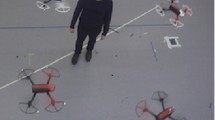Abstract
This paper describes the implementation of a decentralized architecture for autonomous teams of aerial and ground vehicles engaged in active perception. We provide a theoretical framework based on an established approach to the underlying sensor fusion problem [3]. This provides transparent integration of information from heterogeneous sources. The approach is extended to include an information-theoretic utility measure that captures the task objective and robot inter-dependencies. A distributed solution mechanism is employed to determine information maximizing trajectories and assignments subject to the constraints of individual vehicle and sensor sub-systems. This architecture enables the benefit of the complementary aerial and ground based vehicle and sensor capabilities to be realized. The approach is applied to missions involving searching for and tracking multiple ground targets. Experimental results for vehicles equipped with cameras are presented. These illustrate the impact of the team con.guration on overall system performance.
Access this chapter
Tax calculation will be finalised at checkout
Purchases are for personal use only
Preview
Unable to display preview. Download preview PDF.
Similar content being viewed by others
Author information
Authors and Affiliations
Editor information
Rights and permissions
Copyright information
© 2006 Springer-Verlag Berlin Heidelberg
About this paper
Cite this paper
Grocholsky, B., Bayraktar, S., Kumar, V., Taylor, C.J., Pappas, G. (2006). Synergies in Feature Localization by Air-Ground Robot Teams. In: Ang, M.H., Khatib, O. (eds) Experimental Robotics IX. Springer Tracts in Advanced Robotics, vol 21. Springer, Berlin, Heidelberg. https://doi.org/10.1007/11552246_34
Download citation
DOI: https://doi.org/10.1007/11552246_34
Published:
Publisher Name: Springer, Berlin, Heidelberg
Print ISBN: 978-3-540-28816-9
Online ISBN: 978-3-540-33014-1
eBook Packages: EngineeringEngineering (R0)




